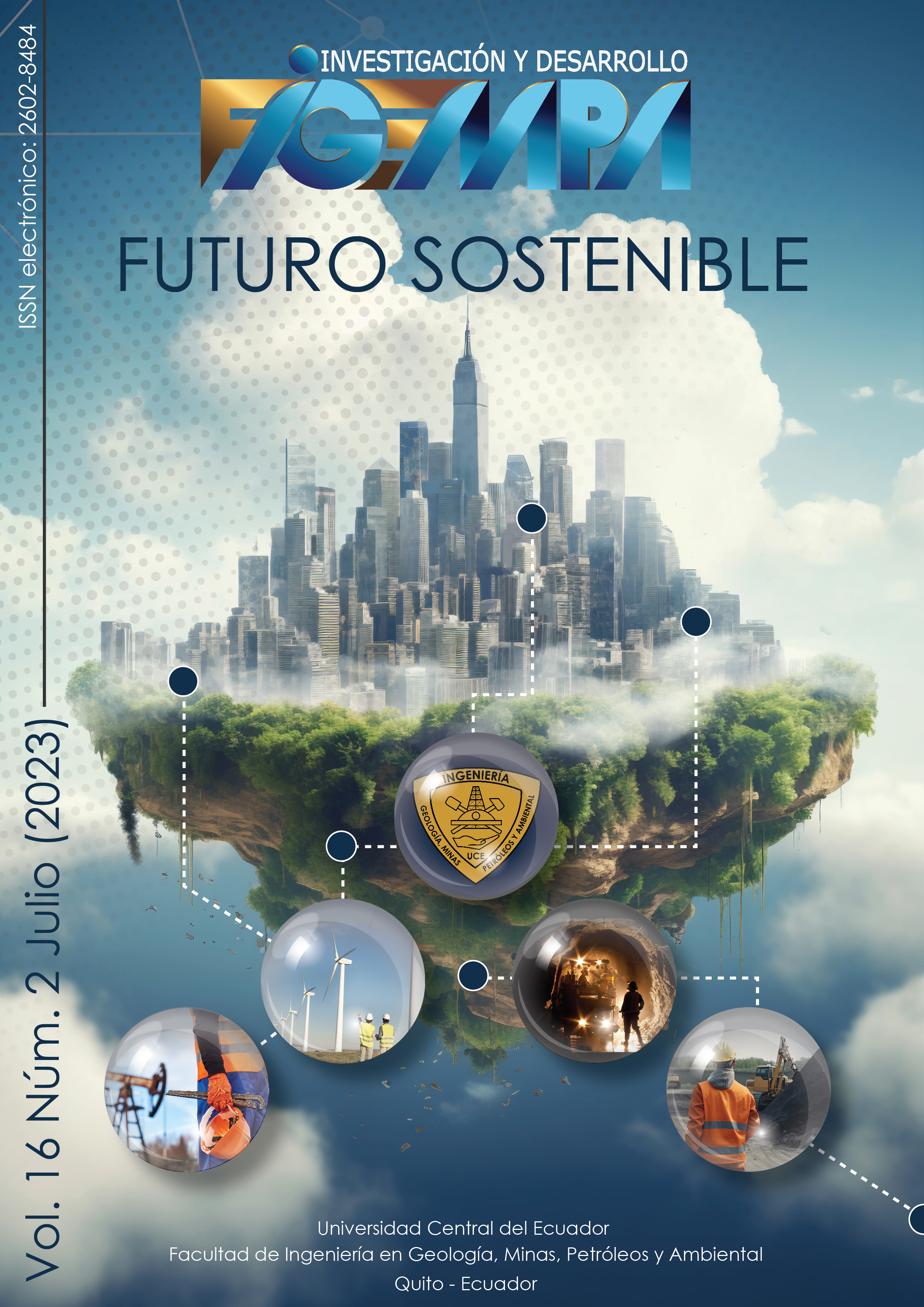Physical and mechanical properties of plastic recyclables produced in Ecuador as construction material
Main Article Content
Abstract
lastic in Ecuador represents 11.43% of the waste generated. As the construction industry has a significant impact on the Ecuadorian economy, it is an ideal place to implement a circular economy model and support a solution using this waste. Plastic wood is proposed as a low-impact material for construction, so its characterization is necessary. In this work, the physical and mechanical characteristics of two types of plastic wood produced in Ecuador, M1 (PET and rice husk) and M2 (polypropylene), were determined using ASTM D regulations (6108, 6109, 638, 2344, 6111, 570, and 2240). The results indicated that plastic wood M1 has higher tensile strength and water absorption capacity due to its natural reinforcement fibers. Additionally, M1 has the highest modulus of elasticity, which gives it greater stiffness and lower deformability. On the other hand, it was observed that M2 has a less compact cross-section and voids in its structure, resulting in greater deformations. In general, plastic wood is advantageous for construction because it has a low probability of being attacked by wood-boring insects and has great potential in the design of axial load elements due to its acceptable performance under compression, tension, and bending, limited to low-rise constructions due to the high deformations it presents.
Downloads
Metrics
Article Details

This work is licensed under a Creative Commons Attribution 4.0 International License.
References
Albán, L. (2019) Elaboración de madera plástica a partir de polímeros post consumo. Universidad Técnica del Norte. http://repositorio.utn.edu.ec/handle/123456789/8868
Alcívar, I., y Arias, G. (2009) Proyecto para la fabricación de un producto sustituto de la madera, con polietileno de alta densidad 100% reciclado. http://repositorio.ucsg.edu.ec/handle/3317/1576
ASTM D570 (2018) Standard Test Method for Water Absorption of Plastics. https://www.astm.org/d0570-98r18.html
ASTM D638 (2014) Standard Test Method for Tensile Properties of Plastics. https://www.astm.org/d0638-14.html
ASTM D2240 (2021) Standard Test Method for Rubber Property—Durometer Hardness. https://www.astm.org/d2240-15r21.html
ASTM D2344 (2016) Standard Test Method for Short-Beam Strength of Polymer Matrix Composite Materials and Their Laminates. https://www.astm.org/d2344_d2344m-22.html
ASTM D6108 (2019) Standard Test Method for Compressive Properties of Plastic Lumber and Shapes. https://www.astm.org/d6108-19.html
ASTM D6109 (2019) Standard Test Methods for Flexural Properties of Unreinforced and Reinforced Plastic Lumber and Related Products. https://www.astm.org/d6109-19.html
ASTM D6111 (2019) Standard Test Method for Bulk Density and Specific Gravity of Plastic Lumber and Shapes by Displacement. https://www.astm.org/d6111-19a.html
Bersoza, M. (2018) Modelo de negocios para la distribuidora ecológica Arvol Disecoarvol Cia. Ltda para el periodo 2018 – 2021. https://dspace.ucuenca.edu.ec/bitstream/123456789/30954/3/Trabajo%20de%20Titulaci%C3%B3n.pdf
Black Rhino Recycling (s/f) Structural Grade Plastic Lumber. Recuperado el 8 de marzo de 2023, de https://www.blackrhinoproducts.com/
Cai, Z. (2021) Mechanical Properties of Wood-Based Composite Materials Contents.
Callister, W., y Rethwisch, D. (2016) Ciencia e Ingeniería de materiales (Reverté). https://www.reverte.com/media/reverte/files/book-attachment-2717.pdf
Chen, J., Wang, Y., Gu, C., Liu, J., Liu, Y., Li, M., y Lu, Y. (2013) Enhancement of the Mechanical Properties of Basalt Fiber-Wood-Plastic Composites via Maleic Anhydride Grafted High-Density Polyethylene (MAPE) Addition. Materials, 6(6), 2483–2496. https://doi.org/10.3390/MA6062483
Chen, R. S., Ab Ghani, M. H., Ahmad, S., Salleh, M. N., y Tarawneh, M. A. (2014) Rice husk flour biocomposites based on recycled high-density polyethylene/polyethylene terephthalate blend: effect of high filler loading on physical, mechanical and thermal properties. SAGE, 49(10), 1241–1253. https://doi.org/10.1177/0021998314533361
Dos Santos, F., Canto, L., da Silva, A., Visconte, L., y Vasques, E. (2020) Processing and properties of plastic lumber. Thermosoftening plastics.
Eco Wiblock (s/f) Recuperado el 22 de marzo de 2023. http://ecowiblock.com/
Ecowood Ecuador (s/f) Recuperado el 22 de marzo de 2023. https://ecowoodecuador.com/
Ecuaplastic (s/f) Recuperado el 22 de marzo de 2023. https://www.ecuaplastic.com/index.php/empresa/quienes-somos
Garcia, J., Quito, J., y Perdomo, J. (2020) Análisis de la huella de carbono en la construcción y su impacto sobre el ambiente. http://hdl.handle.net/20.500.12494/16031
Hapco (s/f) Hardness Comparison Chart. Recuperado el 3 de marzo de 2023. https://hapcoincorporated.com/resources/hardness-comparison-chart/
Herrera, J. P., Bedoya-Ruiz, D., y Hurtado, J. E. (2018) Seismic behavior of recycled plastic lumber walls: An experimental and analytical research. Engineering Structures, 177, 566–578. https://doi.org/10.1016/j.engstruct.2018.10.006
Herrera, J. P., Bedoya-Ruiz, D., y Hurtado, J. E. (2023) Recycled Plastic Lumber walls for one and two-story housing: An assessment of their seismic performance. Journal of Building Engineering, 65, 105822. https://doi.org/10.1016/j.jobe.2023.105822
Hugo, A.M. (2015) Recycled Polymer Composites for Structural Applications [The University Of Sheffield]. https://etheses.whiterose.ac.uk/9520/1/Annie-May%20Hugo%20PHD%20Thesis%20Final.pdf
Iza, D. (2020) Análisis de la composición y propiedades mecánicas de la madera plástica reciclada (WPC). http://repositorio.utc.edu.ec/handle/27000/6833
Klyosov, A. (2007) Wood-Plastic Composites. John Wiley & Sons, Inc.
Madera Plástica Barahona (s/f) Recuperado el 22 de marzo de 2023. https://www.maderaplasticabarahona.com/
Madera Verde Ecuador (s/f) Recuperado el 22 de marzo de 2023. https://madera-verde-ecuador.negocio.site/
Ministerio de Producción y Comercio Exterior e Inversiones y Pesca (2021) Libro Blanco de Economía Circular de Ecuador. https://www.produccion.gob.ec/wp-content/uploads/2021/05/OT-44416_Libro-Blanco_paginas.pdf
Portilla Jiménez, G. J. (2022) Análisis del Marco Normativo de Economía Circular en Ecuador Orientado al Sector de los Plásticos. FIGEMPA: Investigación y Desarrollo, 13(1), 38–47. https://doi.org/10.29166/revfig.v13i1.3364
Recreus (2021, septiembre 1) ¿Qué es la “dureza Shore”? https://recreus.com/es/noticias/aprende-con-recreus/que-es-la-dureza-shore-
Rincón, L., Rodríguez, E., y Espitia, A. (2016) Madera plástica un producto amigo del planeta. Semilleros, 3(5), 41–48.
Salas, J. (2016) De habitat II a Habitat III: construyendo con recursos escasos en Latinoamérica. E.T.S. Arquitectura (UPM).
Secretaría Nacional de Planificación (Ed.) (2021) Plan de Creación de Oportunidades 2021-2025. https://observatorioplanificacion.cepal.org/es/planes/plan-de-creacion-de-oportunidades-2021-2025-de-ecuador
Suhot, M. A., Hassan, M. Z., Aziz, S. A., y Md Daud, M. Y. (2021) Recent Progress of Rice Husk Reinforced Polymer Composites: A Review. Polymers, 13(15), 2391. https://doi.org/10.3390/POLYM13152391
Turku, I., Kärki, T., y Puurtinen, A. (2018) Durability of wood plastic composites manufactured from recycled plastic. Heliyon, 4(3), e00559. https://doi.org/10.1016/J.HELIYON.2018.E00559

